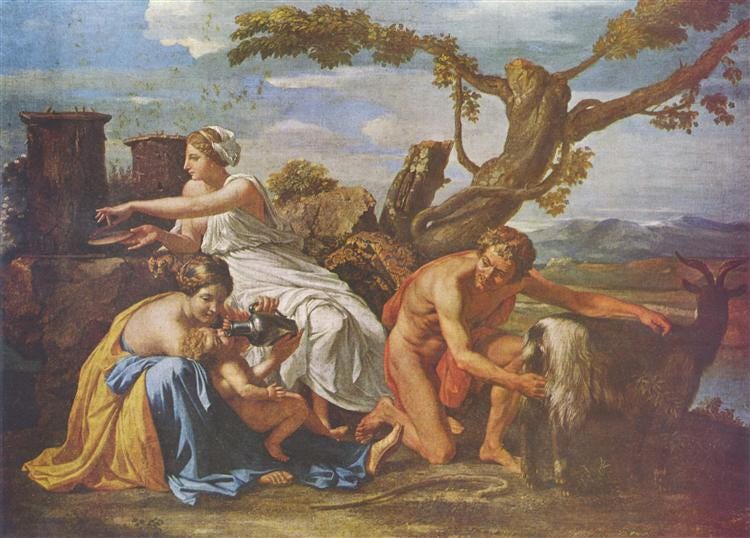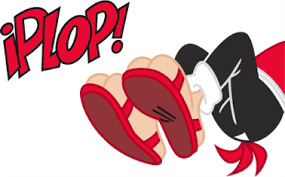The Infant Jupiter Nurtured by the Goat Amalthea by Nicolas Poussin, 1638
Thanks to a tip-off from the ever-informative Marginal Revolution I yesterday discovered a new and important book about ancient Greece:
John Ma, Polis: A New History of the Ancient Greek City-State from the Early Iron Age to the End of Antiquity, Princeton University Press published July 2024.
It has been acclaimed by scholars, including our two Social Science Files subscribers:
“An extraordinary, monumental book. Polis is the most wide-ranging and intellectually ambitious work in ancient Greek history in a generation, a tour de force that will set the agenda for future historians and one that I predict will still be read many years from now.” — Josiah Ober, author of The Rise and Fall of Classical Greece
“A must-read for any student of ancient history. This is the work of a scholar who has perfectly mastered his topic.” — Alain Bresson, author of The Making of the Ancient Greek Economy: Institutions, Markets, and Growth in the City-States
I will read the book before writing about Greece. Already I found themes to home in on. For example, 131 pages deal with “decisions” and “decision making”. There is also a definite focus on the “utilitarian calculus” of “community control over elites”.
As readers know I am currently working on decision making in prehistoric Type 2 society, which I call ‘communalistic’, and I tentatively identified [unlocked] an ancient Greek Type 5 society as characterised by “communalistic assembly participation”.
So, it will be a tremendous help to be able to draw on John Ma’s expert book for ideas and evidence which might be applied to understanding the dynamics of Type 5. Below I exhibit a stimulating and, unusually, ‘documented’ example that appears right at the start of the book (pp. 3-7). It concerns an island society’s efforts to control the goat population. The themes overlap with those of prehistoric and proxy-primitive society.
The Goats of Hērakleia (ca. 270 BCE)
In 1895 or 1896, the French scholar Jules Delamarre, while exploring the island of Amorgos, studied a worn and fragmentary inscription found in modern Irakleia, a small islet in the Eastern Cyclades (or more dramatically, the Erimonisia, the “desert islands”), located to the south of Naxos and to the west of Amorgos. The text, though fragmentary, is nothing less than extraordinary in its implications. In short, it concerned the struggles of a community on ancient Hērakleia to reach a decision about goats; and it deserves full quotation.
[. . . I swear by . . . and Heraklē]s and the other [gods] who hold sway over the island, and if I keep to my oath, may it turn out [well] for me, and if I break my oath may it turn to the opposite. If someone, in trying by force to introduce goats or to raise them, in contravention of this decree and the oath, should kill some men among those who try to prevent it, let the relatives of the victim and the whole commonwealth of the islanders prosecute him; as for whatever expense is incurred for the judgment, let every one contribute his share; and let the hieropoios inscribe this decree on a stone stele and set it up in the shrine of the Mother of the Gods; let the expense of the stele and the inscription come out of the public treasury. These matters are to be considered as concerning the protection and safety of all the Herakleiotes and of the inhabitants [of the island].
As analyzed in a luminous article by French historian Louis Robert, the inscribed document, datable to the first half of the third century BCE on paleographical grounds, preserves the end of a momentous decision by a political community, the Herakleiotes. In a formal meeting (the details of which are now lost), framed by the working of their institutions, the Herakleiotes decided not to keep goats on the island. They further took care of the implementation of this decision, through the imposition of an oath to respect the decision (this is where the preserved text starts). They also offered the guarantee of communal prosecution in case any attempt at stopping the introduction of goats onto the island resulted in death.
The decision mobilized common institutional resources — deliberative, judicial, financial, but also ideological. Its measures were formally declared necessary for the community’s safety (phulakē kaisōtēria), a legal category protecting it against amendment or reversal, but also an invocation of the public good. The document, transcribing the whole transaction of the meeting in its institutional setting (including the motion as proposed, and almost certainly procedural details such as the proposers of the motion and the presiding bodies at the meeting), was inscribed in permanent form and displayed in a sacred space, the shrine of the Mother of the Gods, as a record and as a monument of the political community in action. Such inscribed decrees are a major source for the history of ancient Greek communities and their account echoes down this book. …
… third-century BCE Hērakleia was neither a wilderness of many sheep and a couple of herdsmen, nor a depressed feudal world of sharecropping peasants dealing with absentee landlords and hostile laws, but the site of an egalitarian political community with the collective capacities to decide its own fate.
What should we call this political community? It regulates itself; it can take independent decisions in deliberative assembly, without referring to a higher authority (hence the phulakē clause safeguarding the measures). It has institutions — political, administrative, judicial, religious — and controls its own spaces, from a whole territory to the shrine where the decree was inscribed. It is immediately tempting to call it the polis, or city-state, of the Herakleiotes. However, it is also true that the word polis never occurs in our fragmentary text. Instead, it mentions legal action taken by “the whole koinon (community) of the islanders,” and at the end, “all the Herakleiotes and those who inhabit the island.” Hence, another interpretation would be to see this decision as taken by an association of inhabitants on the island (dealing with encroachment by herd owners on Amorgos) rather than a city-state, since the term koinon can be used for groups and associations … Another possibility … would be that the decree was passed by a local subdivision or official body within a larger polis (for instance Amorgos).
My own understanding of the nuanced poetics of community in the decree is the following. There exists a corporate group of entitled and enfranchised men, the Herakleiōtai, with a reified name (an ethnikon, to use the technical term) which shows that they claim to be the stakeholders of political community on the island—in other words, that they constitute a polis. That they can take their own independent decisions, wielding a phulakē clause (of a type that is only found used by poleis as states) shows that they are a polis endowed with state capacities, drawing notably on common funds (koinon, a term which can designate things owned by the polis but also the polis itself as community). The introduction of goats is an internal affair (since those who do it would infringe their own oath), and hence the decree is about an effort at autoregulation by a community of citizens.
But there also are other people on the island, who do not have access to state institutional power — women, children, foreigners, enslaved people — and appear in the last clause as the inhabitants of the island: the phulakē clause concerns more than just the polis or the dēmos (the People constituted by citizens), but all inhabitants. …
… The polis of Hērakleia is a set of political institutions but also a society, whose welfare is directly concerned by the decree formally passed by the Herakleiotes. The “whole koinon of the islanders” is a striking expression, insisting not just on the community (koinon) that is represented by the group of citizen Herakleiotes but putting forward a new, more capacious category of all those that occupy the island. The practical purpose is to explain that every one in the social assemblage on Hērakleia will be liable for taxation—an exceptional levy, eisphora—to cover the judicial costs potentially involved in enforcing the ban; but this sense of the broader community also emerges in the unusual extension of the phulakē clause to concern the safety of all the inhabitants. The very complexity of the relations between the political community of adult male citizens, and the rest of the human society within the same space, is an indication that we are looking at a polis. …
… The mystery thickens when we realize that the inscription with the decree barring goats is the only written artifact from the polis of Hērakleia; there are no other documents, and no record of material remains . … Did the polis manage to maintain itself after this particular crisis …? At least, the document shows clearly the polis as a political form (decision-making, law, ideology), as a social form (small property owners free from direct control by landowners but subject to communally decided restraints on rights), and as a social relation (political community of adult male citizens, within “the whole koinon” of society). These three aspects form the theme of the present book.
In modern society, the feral goats
By coincidence, equivalent goat-related issues have been in the newspapers today.
One of the special beauties of modern Western society is the ability to harness the market within an institutional framework which simultaneously guarantees rule of law with property rights, impersonal administration of laws, and fully representative legislatures for the continual reformulation of laws. This tripartite institutionalised system we now call the ‘state’. Given the dynamic mixture of ingenuity of free private competition with stability of state oversight, the proliferating goats, which were a vexation and danger to public safety on the roads (as I discovered during explorations of the Australian outback 2017-2020), are now a highly marketable global commodity.
Moreover in Western societies suffering the irreversible consequences of two decades of out-of-control human migration [“we will live with the consequences for the rest of all our lives”], goat meat sales have surged among some ethnic-religious communities, as reported in the most recent Global Livestock Snapshot May 2024 [pdf].
Goat meat sales are also booming in China, which, much to the chagrin of poorer developing countries, continues to dump cheap industrial goods (often made using pilfered Western technologies) in emerging markets which struggle valiantly to climb an industrial value chain — “Many developing countries now fear they will endure the same kind of “China Shock” that gutted U.S. industry starting a quarter-century ago”.
We might therefore anticipate that when Western polities do eventually join forces to control global migration chaos and also to contain China’s distortional market-rigging impact on the entire global economy we will see a sharp natural capitalistic market-responsive decline in goat harvesting. Then, as on the Greek island ca. 270 BCE, there will be a natural need for formal legal decrees designed to eliminate or suppress the out-of-control counter-utilitarian reproduction of goats on the ‘island’ of Australia.
Here is a revealing 9 minute video from Australia’s public broadcaster, the ABC.
It is worth noting, since the opportunity has arisen , that there is a Conservative Case for Public Broadcasting. Another overdue job for the Australian polity to tackle.
But goats are so sweet and so popular now as pets, as today’s Telegraph reports — What really upsets goats most is the modern machine.
My thanks to the Wall Street Journal, the Spectator, the Telegraph, and conservative Condorito
Dr Michael G. Heller





![Theory & History [3]](https://substackcdn.com/image/fetch/w_1300,h_650,c_fill,f_auto,q_auto:good,fl_progressive:steep,g_auto/https%3A%2F%2Fsubstack-post-media.s3.amazonaws.com%2Fpublic%2Fimages%2F915dec68-bf7b-4544-a84e-08b76f9eac81_685x462.jpeg)

